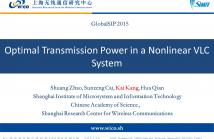- Read more about Wireless Network Recommendation System in Heterogeneous Networks
- Log in to post comments
- Categories:
 14 Views
14 Views- Read more about Interference Model and Analysis on Device-to-Device Cellular Coexist Networks
- Log in to post comments
Device-to-device (D2D) communications can enhance the overall system capacity by reusing cellular spectrum, which at the same time leads to severe interference to cellular connections and vice versa. In practice, even when two wireless connections share the same spectrum, the interference between them may not always exist if there is no conflict at packet-level transmissions. Thus, in this paper, we establish a cross-layer model for D2D communications underlaying cellular network to characterize the realistic interference scenario.
- Categories:
 6 Views
6 Views- Read more about On the Superposition Modulation for OFDM- based Optical Wireless Communication
- Log in to post comments
Inherent unipolar orthogonal frequency division multiplexing (OFDM) schemes have a reduced spectral efficiency (SE) when compared with direct current (DC)-biased optical OFDM (DCO-OFDM). The concept of superposition modulation was proposed as a solution to the SE loss of unipolar orthogonal frequency division multiplexing (U-OFDM) and the power efficiency loss of pulse-amplitude-modulated discrete multitone modulation (PAM-DMT).
- Categories:
 25 Views
25 Views- Read more about Ergodic Rate Analysis for Massive MIMO Relay Systems with Multi-Pair Users under Imperfect CSI
- Log in to post comments
- Categories:
 10 Views
10 Views- Read more about Accurate Carrier Frequency Offset Estimation in Time-Reversal Communications
- 1 comment
- Log in to post comments
Time-reversal (TR) wideband communication could harvest the energy from the rich-scattering environment and enjoy the unique spatial and temporal focusing effect. However, the performance degrades in the presence of carrier frequency offset (CFO), which introduces an additional phase linear in time. CFO estimators could mitigate its effect. Yet, conventional CFO estimators cannot work well regarding the tiny CFO due to the high sampling rate in wideband TR systems. To address this issue, we propose four CFO estimators which are capable to estimate very small CFO with very high accuracy.
- Categories:
 20 Views
20 Views
- Categories:
 9 Views
9 Views- Read more about Jointly Optimal Power and Rate Allocation for Layered Broadcast Over Amplify-and-Forward Relay Channels
- Log in to post comments
This is an overview presentation of our recent work which is jointly optimize the power and rate allocation procedure for the multi-layer transmission case. This is an extension of a previous work in the context of a relay-assisted channel applying AF relaying.
For more information see the full paper:
Mohamed A. Attia, Mohammad Shaqfeh, Karim G. Seddik, and Hussein Alnuweiri, "Jointly Optimal Power and Rate Allocation for Layered Broadcast Over Amplify-and-Forward Relay Channels", GlobalSIP 2015.
presentation.pdf
- Categories:
 1 Views
1 Views- Read more about presentation: energy efficiency analysis of base station in centralized radio access networks
- Log in to post comments
- Categories:
 17 Views
17 Views
- Read more about Enabling Heterogeneous Connectivity in Internet of Things: A Time-Reversal Approach
- Log in to post comments
With the pervasive presence of massive smart devices, Internet of Things (IoT) is enabled by wireless communication technology. The devices in IoT usually have very diverse bandwidth capabilities, and thus in need of many communication standards. To facilitate communications between these heterogeneous bandwidths of devices, middlewares have often been developed. However, they are often not suitable for resource constrained scenario due to their complexity. It leads us to ask is there a unified approach that can support the communication between the devices with heterogeneous bandwidths?
- Categories:
 12 Views
12 Views